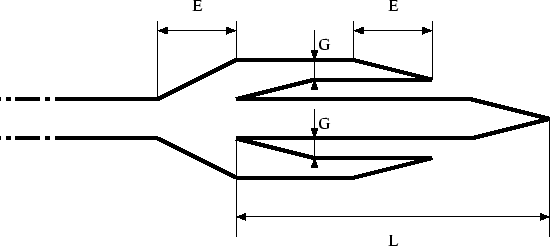Double-Tuck Fold |

|

|

|

|
|
Double-Tuck Fold |

|

|

|

|
As seen in the previous section, when subsequent simple tucks are applied, the algorithm considers that the whole "slave" part will enter between the "master" layers. This is not always the case, as shown in Figure 26. In this case, the first tuck is longer than the second one and it "exits" again after the second fold.

Figure 26: The idea of a double-tuck fold.
The "Double-tuck" operator is designed to deal with this type of fold. Its parameters are the same as those of previously described folds (element width, minimum gap, maximum ![]() tangent) plus the length of the first tuck.
tangent) plus the length of the first tuck.

Figure 27: The shape of a double-tuck.
The shape of the double-tuck fold is described in the Figure 27 where E is the minimum element size, L is the first tuck length, and G is the minimum gap value.